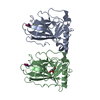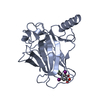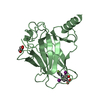[English] 日本語
 Yorodumi
Yorodumi- PDB-8a31: p53 cancer mutant Y220C in complex with iodophenol-based small-mo... -
+ Open data
Open data
- Basic information
Basic information
| Entry | Database: PDB / ID: 8a31 | ||||||
|---|---|---|---|---|---|---|---|
| Title | p53 cancer mutant Y220C in complex with iodophenol-based small-molecule stabilizer JC694 | ||||||
 Components Components | Cellular tumor antigen p53 | ||||||
 Keywords Keywords | TRANSCRIPTION / tumor suppressor p53 / cancer mutant / drug discovery / small-molecule stabilizer | ||||||
| Function / homology |  Function and homology information Function and homology informationLoss of function of TP53 in cancer due to loss of tetramerization ability / Regulation of TP53 Expression / signal transduction by p53 class mediator / negative regulation of G1 to G0 transition / negative regulation of glucose catabolic process to lactate via pyruvate / Transcriptional activation of cell cycle inhibitor p21 / regulation of intrinsic apoptotic signaling pathway by p53 class mediator / Activation of NOXA and translocation to mitochondria / negative regulation of pentose-phosphate shunt / ATP-dependent DNA/DNA annealing activity ...Loss of function of TP53 in cancer due to loss of tetramerization ability / Regulation of TP53 Expression / signal transduction by p53 class mediator / negative regulation of G1 to G0 transition / negative regulation of glucose catabolic process to lactate via pyruvate / Transcriptional activation of cell cycle inhibitor p21 / regulation of intrinsic apoptotic signaling pathway by p53 class mediator / Activation of NOXA and translocation to mitochondria / negative regulation of pentose-phosphate shunt / ATP-dependent DNA/DNA annealing activity / negative regulation of helicase activity / regulation of cell cycle G2/M phase transition / intrinsic apoptotic signaling pathway in response to hypoxia / regulation of fibroblast apoptotic process / oxidative stress-induced premature senescence / oligodendrocyte apoptotic process / negative regulation of miRNA processing / positive regulation of thymocyte apoptotic process / regulation of tissue remodeling / glucose catabolic process to lactate via pyruvate / positive regulation of mitochondrial membrane permeability / negative regulation of mitophagy / positive regulation of programmed necrotic cell death / mRNA transcription / bone marrow development / circadian behavior / histone deacetylase regulator activity / germ cell nucleus / T cell lineage commitment / regulation of mitochondrial membrane permeability involved in apoptotic process / RUNX3 regulates CDKN1A transcription / regulation of DNA damage response, signal transduction by p53 class mediator / TP53 regulates transcription of additional cell cycle genes whose exact role in the p53 pathway remain uncertain / TP53 Regulates Transcription of Death Receptors and Ligands / Activation of PUMA and translocation to mitochondria / DNA damage response, signal transduction by p53 class mediator resulting in transcription of p21 class mediator / B cell lineage commitment / thymocyte apoptotic process / negative regulation of glial cell proliferation / negative regulation of neuroblast proliferation / Regulation of TP53 Activity through Association with Co-factors / mitochondrial DNA repair / Formation of Senescence-Associated Heterochromatin Foci (SAHF) / TP53 Regulates Transcription of Caspase Activators and Caspases / ER overload response / positive regulation of release of cytochrome c from mitochondria / negative regulation of DNA replication / positive regulation of cardiac muscle cell apoptotic process / TP53 regulates transcription of several additional cell death genes whose specific roles in p53-dependent apoptosis remain uncertain / entrainment of circadian clock by photoperiod / cardiac septum morphogenesis / PI5P Regulates TP53 Acetylation / Association of TriC/CCT with target proteins during biosynthesis / necroptotic process / Zygotic genome activation (ZGA) / positive regulation of execution phase of apoptosis / TP53 Regulates Transcription of Genes Involved in Cytochrome C Release / TFIID-class transcription factor complex binding / rRNA transcription / negative regulation of telomere maintenance via telomerase / SUMOylation of transcription factors / intrinsic apoptotic signaling pathway by p53 class mediator / general transcription initiation factor binding / intrinsic apoptotic signaling pathway in response to endoplasmic reticulum stress / Transcriptional Regulation by VENTX / DNA damage response, signal transduction by p53 class mediator / response to X-ray / replicative senescence / Pyroptosis / mitophagy / cellular response to UV-C / positive regulation of RNA polymerase II transcription preinitiation complex assembly / neuroblast proliferation / hematopoietic stem cell differentiation / negative regulation of reactive oxygen species metabolic process / intrinsic apoptotic signaling pathway in response to DNA damage by p53 class mediator / somitogenesis / embryonic organ development / chromosome organization / T cell proliferation involved in immune response / type II interferon-mediated signaling pathway / glial cell proliferation / viral process / cis-regulatory region sequence-specific DNA binding / TP53 Regulates Transcription of Genes Involved in G1 Cell Cycle Arrest / hematopoietic progenitor cell differentiation / cellular response to actinomycin D / positive regulation of intrinsic apoptotic signaling pathway / cellular response to glucose starvation / core promoter sequence-specific DNA binding / negative regulation of stem cell proliferation / mitotic G1 DNA damage checkpoint signaling / negative regulation of fibroblast proliferation / gastrulation / MDM2/MDM4 family protein binding / tumor necrosis factor-mediated signaling pathway / response to salt stress / cardiac muscle cell apoptotic process / 14-3-3 protein binding / Regulation of TP53 Activity through Acetylation Similarity search - Function | ||||||
| Biological species |  Homo sapiens (human) Homo sapiens (human) | ||||||
| Method |  X-RAY DIFFRACTION / X-RAY DIFFRACTION /  SYNCHROTRON / SYNCHROTRON /  FOURIER SYNTHESIS / Resolution: 1.46 Å FOURIER SYNTHESIS / Resolution: 1.46 Å | ||||||
 Authors Authors | Balourdas, D.I. / Stephenson Clarke, J.R. / Baud, M.G.J. / Knapp, S. / Joerger, A.C. / Structural Genomics Consortium (SGC) | ||||||
| Funding support |  Germany, 1items Germany, 1items
| ||||||
 Citation Citation |  Journal: Acs Pharmacol Transl Sci / Year: 2022 Journal: Acs Pharmacol Transl Sci / Year: 2022Title: Discovery of Nanomolar-Affinity Pharmacological Chaperones Stabilizing the Oncogenic p53 Mutant Y220C. Authors: Stephenson Clarke, J.R. / Douglas, L.R. / Duriez, P.J. / Balourdas, D.I. / Joerger, A.C. / Khadiullina, R. / Bulatov, E. / Baud, M.G.J. | ||||||
| History |
|
- Structure visualization
Structure visualization
| Structure viewer | Molecule:  Molmil Molmil Jmol/JSmol Jmol/JSmol |
|---|
- Downloads & links
Downloads & links
- Download
Download
| PDBx/mmCIF format |  8a31.cif.gz 8a31.cif.gz | 215.2 KB | Display |  PDBx/mmCIF format PDBx/mmCIF format |
|---|---|---|---|---|
| PDB format |  pdb8a31.ent.gz pdb8a31.ent.gz | 142.3 KB | Display |  PDB format PDB format |
| PDBx/mmJSON format |  8a31.json.gz 8a31.json.gz | Tree view |  PDBx/mmJSON format PDBx/mmJSON format | |
| Others |  Other downloads Other downloads |
-Validation report
| Summary document |  8a31_validation.pdf.gz 8a31_validation.pdf.gz | 1.7 MB | Display |  wwPDB validaton report wwPDB validaton report |
|---|---|---|---|---|
| Full document |  8a31_full_validation.pdf.gz 8a31_full_validation.pdf.gz | 1.7 MB | Display | |
| Data in XML |  8a31_validation.xml.gz 8a31_validation.xml.gz | 20.8 KB | Display | |
| Data in CIF |  8a31_validation.cif.gz 8a31_validation.cif.gz | 31 KB | Display | |
| Arichive directory |  https://data.pdbj.org/pub/pdb/validation_reports/a3/8a31 https://data.pdbj.org/pub/pdb/validation_reports/a3/8a31 ftp://data.pdbj.org/pub/pdb/validation_reports/a3/8a31 ftp://data.pdbj.org/pub/pdb/validation_reports/a3/8a31 | HTTPS FTP |
-Related structure data
| Related structure data |  8a32C  6shzS S: Starting model for refinement C: citing same article ( |
|---|---|
| Similar structure data | Similarity search - Function & homology  F&H Search F&H Search |
- Links
Links
- Assembly
Assembly
| Deposited unit | 
| ||||||||||||
|---|---|---|---|---|---|---|---|---|---|---|---|---|---|
| 1 | 
| ||||||||||||
| 2 | 
| ||||||||||||
| Unit cell |
|
- Components
Components
| #1: Protein | Mass: 24530.811 Da / Num. of mol.: 2 / Fragment: DNA-binding domain Source method: isolated from a genetically manipulated source Source: (gene. exp.)  Homo sapiens (human) / Gene: TP53, P53 / Production host: Homo sapiens (human) / Gene: TP53, P53 / Production host:  #2: Chemical | #3: Chemical | #4: Chemical | ChemComp-GOL / | #5: Water | ChemComp-HOH / | Has ligand of interest | Y | |
|---|
-Experimental details
-Experiment
| Experiment | Method:  X-RAY DIFFRACTION / Number of used crystals: 1 X-RAY DIFFRACTION / Number of used crystals: 1 |
|---|
- Sample preparation
Sample preparation
| Crystal | Density Matthews: 2.47 Å3/Da / Density % sol: 50.26 % |
|---|---|
| Crystal grow | Temperature: 293 K / Method: vapor diffusion, sitting drop Details: Protein solution: 5.7 mg/ml protein in 25 mM sodium phosphate, pH 7.2, 150 mm NaCl, 0.5 mM TCEP. Reservoir buffer: 100 mm HEPES, pH 7.2, 19% (w/v) polyethylene glycol 4000, 5 mm DTT. Soaking ...Details: Protein solution: 5.7 mg/ml protein in 25 mM sodium phosphate, pH 7.2, 150 mm NaCl, 0.5 mM TCEP. Reservoir buffer: 100 mm HEPES, pH 7.2, 19% (w/v) polyethylene glycol 4000, 5 mm DTT. Soaking buffer: 20 mM compound in 100 mm HEPES, pH 7.2, 10 mM sodium phosphate, pH 7.2, 19% (w/v) polyethylene glycol 4000, 20 % (v/v) glycerol, 150 mm NaCl. |
-Data collection
| Diffraction | Mean temperature: 100 K / Serial crystal experiment: N |
|---|---|
| Diffraction source | Source:  SYNCHROTRON / Site: SYNCHROTRON / Site:  SLS SLS  / Beamline: X06SA / Wavelength: 0.999998 Å / Beamline: X06SA / Wavelength: 0.999998 Å |
| Detector | Type: DECTRIS EIGER X 16M / Detector: PIXEL / Date: Dec 18, 2020 |
| Radiation | Protocol: SINGLE WAVELENGTH / Monochromatic (M) / Laue (L): M / Scattering type: x-ray |
| Radiation wavelength | Wavelength: 0.999998 Å / Relative weight: 1 |
| Reflection | Resolution: 1.46→49.5 Å / Num. obs: 84274 / % possible obs: 99.2 % / Redundancy: 5.6 % / Biso Wilson estimate: 14.3992113092 Å2 / CC1/2: 0.999 / Rmerge(I) obs: 0.062 / Net I/σ(I): 12.9 |
| Reflection shell | Resolution: 1.46→1.48 Å / Redundancy: 5.8 % / Rmerge(I) obs: 0.821 / Mean I/σ(I) obs: 2.3 / Num. unique obs: 4099 / CC1/2: 0.911 / % possible all: 98.2 |
- Processing
Processing
| Software |
| |||||||||||||||||||||||||||||||||||||||||||||||||||||||||||||||||||||||||||||||||||||||||||||||||||||||||||||||||||||||||||||||||||||||||||||||||||||||||||||||||||||||||||||||||||||||||||||||||||||||||||||||||||||||||
|---|---|---|---|---|---|---|---|---|---|---|---|---|---|---|---|---|---|---|---|---|---|---|---|---|---|---|---|---|---|---|---|---|---|---|---|---|---|---|---|---|---|---|---|---|---|---|---|---|---|---|---|---|---|---|---|---|---|---|---|---|---|---|---|---|---|---|---|---|---|---|---|---|---|---|---|---|---|---|---|---|---|---|---|---|---|---|---|---|---|---|---|---|---|---|---|---|---|---|---|---|---|---|---|---|---|---|---|---|---|---|---|---|---|---|---|---|---|---|---|---|---|---|---|---|---|---|---|---|---|---|---|---|---|---|---|---|---|---|---|---|---|---|---|---|---|---|---|---|---|---|---|---|---|---|---|---|---|---|---|---|---|---|---|---|---|---|---|---|---|---|---|---|---|---|---|---|---|---|---|---|---|---|---|---|---|---|---|---|---|---|---|---|---|---|---|---|---|---|---|---|---|---|---|---|---|---|---|---|---|---|---|---|---|---|---|---|---|---|
| Refinement | Method to determine structure:  FOURIER SYNTHESIS FOURIER SYNTHESISStarting model: 6shz Resolution: 1.46→47.9807 Å / SU ML: 0.120112289612 / Cross valid method: FREE R-VALUE / σ(F): 1.33787302829 / Phase error: 20.7665322381 Stereochemistry target values: GeoStd + Monomer Library + CDL v1.2
| |||||||||||||||||||||||||||||||||||||||||||||||||||||||||||||||||||||||||||||||||||||||||||||||||||||||||||||||||||||||||||||||||||||||||||||||||||||||||||||||||||||||||||||||||||||||||||||||||||||||||||||||||||||||||
| Solvent computation | Shrinkage radii: 0.9 Å / VDW probe radii: 1.11 Å / Solvent model: FLAT BULK SOLVENT MODEL | |||||||||||||||||||||||||||||||||||||||||||||||||||||||||||||||||||||||||||||||||||||||||||||||||||||||||||||||||||||||||||||||||||||||||||||||||||||||||||||||||||||||||||||||||||||||||||||||||||||||||||||||||||||||||
| Displacement parameters | Biso mean: 21.1746285667 Å2 | |||||||||||||||||||||||||||||||||||||||||||||||||||||||||||||||||||||||||||||||||||||||||||||||||||||||||||||||||||||||||||||||||||||||||||||||||||||||||||||||||||||||||||||||||||||||||||||||||||||||||||||||||||||||||
| Refinement step | Cycle: LAST / Resolution: 1.46→47.9807 Å
| |||||||||||||||||||||||||||||||||||||||||||||||||||||||||||||||||||||||||||||||||||||||||||||||||||||||||||||||||||||||||||||||||||||||||||||||||||||||||||||||||||||||||||||||||||||||||||||||||||||||||||||||||||||||||
| Refine LS restraints |
| |||||||||||||||||||||||||||||||||||||||||||||||||||||||||||||||||||||||||||||||||||||||||||||||||||||||||||||||||||||||||||||||||||||||||||||||||||||||||||||||||||||||||||||||||||||||||||||||||||||||||||||||||||||||||
| LS refinement shell |
|
 Movie
Movie Controller
Controller


 PDBj
PDBj





















